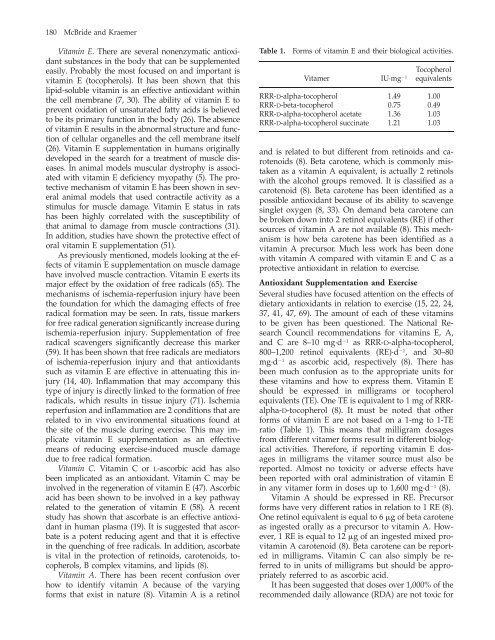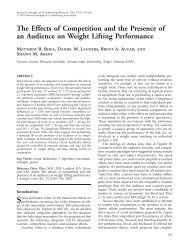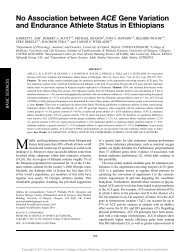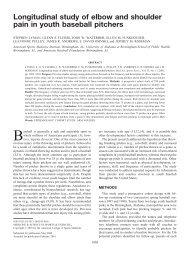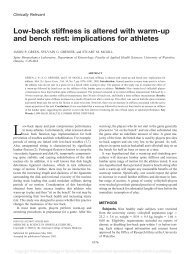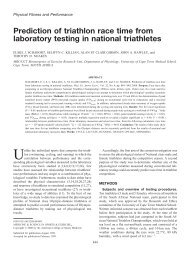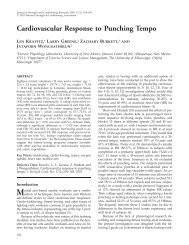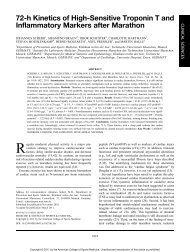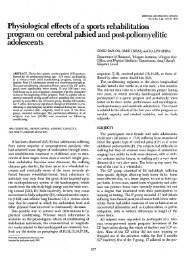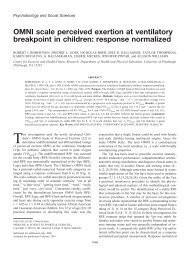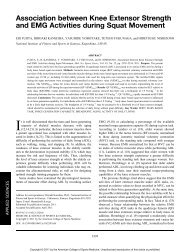Free Radicals, Exercise, and Antioxidants - Setanta College
Free Radicals, Exercise, and Antioxidants - Setanta College
Free Radicals, Exercise, and Antioxidants - Setanta College
You also want an ePaper? Increase the reach of your titles
YUMPU automatically turns print PDFs into web optimized ePapers that Google loves.
180 McBride <strong>and</strong> Kraemer<br />
Vitamin E. There are several nonenzymatic antioxidant<br />
substances in the body that can be supplemented<br />
easily. Probably the most focused on <strong>and</strong> important is<br />
vitamin E (tocopherols). It has been shown that this<br />
lipid-soluble vitamin is an effective antioxidant within<br />
the cell membrane (7, 30). The ability of vitamin E to<br />
prevent oxidation of unsaturated fatty acids is believed<br />
to be its primary function in the body (26). The absence<br />
of vitamin E results in the abnormal structure <strong>and</strong> function<br />
of cellular organelles <strong>and</strong> the cell membrane itself<br />
(26). Vitamin E supplementation in humans originally<br />
developed in the search for a treatment of muscle diseases.<br />
In animal models muscular dystrophy is associated<br />
with vitamin E deficiency myopathy (5). The protective<br />
mechanism of vitamin E has been shown in several<br />
animal models that used contractile activity as a<br />
stimulus for muscle damage. Vitamin E status in rats<br />
has been highly correlated with the susceptibility of<br />
that animal to damage from muscle contractions (31).<br />
In addition, studies have shown the protective effect of<br />
oral vitamin E supplementation (51).<br />
As previously mentioned, models looking at the effects<br />
of vitamin E supplementation on muscle damage<br />
have involved muscle contraction. Vitamin E exerts its<br />
major effect by the oxidation of free radicals (65). The<br />
mechanisms of ischemia-reperfusion injury have been<br />
the foundation for which the damaging effects of free<br />
radical formation may be seen. In rats, tissue markers<br />
for free radical generation significantly increase during<br />
ischemia-reperfusion injury. Supplementation of free<br />
radical scavengers significantly decrease this marker<br />
(59). It has been shown that free radicals are mediators<br />
of ischemia-reperfusion injury <strong>and</strong> that antioxidants<br />
such as vitamin E are effective in attenuating this injury<br />
(14, 40). Inflammation that may accompany this<br />
type of injury is directly linked to the formation of free<br />
radicals, which results in tissue injury (71). Ischemia<br />
reperfusion <strong>and</strong> inflammation are 2 conditions that are<br />
related to in vivo environmental situations found at<br />
the site of the muscle during exercise. This may implicate<br />
vitamin E supplementation as an effective<br />
means of reducing exercise-induced muscle damage<br />
due to free radical formation.<br />
Vitamin C. Vitamin C or L-ascorbic acid has also<br />
been implicated as an antioxidant. Vitamin C may be<br />
involved in the regeneration of vitamin E (47). Ascorbic<br />
acid has been shown to be involved in a key pathway<br />
related to the generation of vitamin E (58). A recent<br />
study has shown that ascorbate is an effective antioxidant<br />
in human plasma (19). It is suggested that ascorbate<br />
is a potent reducing agent <strong>and</strong> that it is effective<br />
in the quenching of free radicals. In addition, ascorbate<br />
is vital in the protection of retinoids, carotenoids, tocopherols,<br />
B complex vitamins, <strong>and</strong> lipids (8).<br />
Vitamin A. There has been recent confusion over<br />
how to identify vitamin A because of the varying<br />
forms that exist in nature (8). Vitamin A is a retinol<br />
Table 1. Forms of vitamin E <strong>and</strong> their biological activities.<br />
Vitamer IU·mg 1<br />
RRR-D-alpha-tocopherol<br />
RRR-D-beta-tocopherol<br />
RRR-D-alpha-tocopherol acetate<br />
RRR-D-alpha-tocopherol succinate<br />
1.49<br />
0.75<br />
1.36<br />
1.21<br />
Tocopherol<br />
equivalents<br />
1.00<br />
0.49<br />
1.03<br />
1.03<br />
<strong>and</strong> is related to but different from retinoids <strong>and</strong> carotenoids<br />
(8). Beta carotene, which is commonly mistaken<br />
as a vitamin A equivalent, is actually 2 retinols<br />
with the alcohol groups removed. It is classified as a<br />
carotenoid (8). Beta carotene has been identified as a<br />
possible antioxidant because of its ability to scavenge<br />
singlet oxygen (8, 33). On dem<strong>and</strong> beta carotene can<br />
be broken down into 2 retinol equivalents (RE) if other<br />
sources of vitamin A are not available (8). This mechanism<br />
is how beta carotene has been identified as a<br />
vitamin A precursor. Much less work has been done<br />
with vitamin A compared with vitamin E <strong>and</strong> C as a<br />
protective antioxidant in relation to exercise.<br />
Antioxidant Supplementation <strong>and</strong> <strong>Exercise</strong><br />
Several studies have focused attention on the effects of<br />
dietary antioxidants in relation to exercise (15, 22, 24,<br />
37, 41, 47, 69). The amount of each of these vitamins<br />
to be given has been questioned. The National Research<br />
Council recommendations for vitamins E, A,<br />
<strong>and</strong> C are 8–10 mg·d1 as RRR-D-alpha-tocopherol,<br />
800–1,200 retinol equivalents (RE)·d1 , <strong>and</strong> 30–80<br />
mg·d1 as ascorbic acid, respectively (8). There has<br />
been much confusion as to the appropriate units for<br />
these vitamins <strong>and</strong> how to express them. Vitamin E<br />
should be expressed in milligrams or tocopherol<br />
equivalents (TE). One TE is equivalent to 1 mg of RRRalpha-D-tocopherol<br />
(8). It must be noted that other<br />
forms of vitamin E are not based on a 1-mg to 1-TE<br />
ratio (Table 1). This means that milligram dosages<br />
from different vitamer forms result in different biological<br />
activities. Therefore, if reporting vitamin E dosages<br />
in milligrams the vitamer source must also be<br />
reported. Almost no toxicity or adverse effects have<br />
been reported with oral administration of vitamin E<br />
in any vitamer form in doses up to 1,600 mg·d1 (8).<br />
Vitamin A should be expressed in RE. Precursor<br />
forms have very different ratios in relation to 1 RE (8).<br />
One retinol equivalent is equal to 6 g of beta carotene<br />
as ingested orally as a precursor to vitamin A. However,<br />
1 RE is equal to 12 g of an ingested mixed provitamin<br />
A carotenoid (8). Beta carotene can be reported<br />
in milligrams. Vitamin C can also simply be referred<br />
to in units of milligrams but should be appropriately<br />
referred to as ascorbic acid.<br />
It has been suggested that doses over 1,000% of the<br />
recommended daily allowance (RDA) are not toxic for


